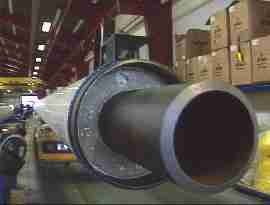District Heating Main
District Heating Systems are extremely common in larger building complexes such as large Hospital sites
where Wards and departments can be widely distributed. Systems such as this utilise large boilerhouses
situated either in a central location or on the perimeter of the site. In these cases, the fuel used for
firing the boilers is delivered by oil or coal delivery vehicles or by external Gas mains. Hot water is
heated and circulated throughout the site via a network of flow and return pipework. At individual blocks,
the main circulation is either shunted through a blending or BIBO station or heat is transferred by means
of a calorifier or plate heat exchanger.
Systems such as this are also widely used in over 90
localised district heating schemes in Glasgow, where relatively small blocks or groups of dwellings are
served with heating and domestic hot water services. These have in some cases been in common use for many
years.
The concept of using District Heating methods such as these for the purpose of distributing
heat energy around a community, district or more widely throughout a town or city is however relatively
new or novel in this country.
However District Heating has been used in this way for many years
in Europe and in particular is very common in Scandinavian Countries. In Denmark more than half of all
homes are heated from District or Community heating systems. One could not fail to be impressed by the
scale of the waste-to-energy plants and the associated pipe networks that can be seen in use and being
extended in Cities such as Copenhagen. There, the schemes are now in mandatory use and hospitals and most
other public buildings.
In the United Kingdom, use of such systems has not been very widespread. Mention has already been
made of those relatively small schemes in use in Glasgow. However there have been some very successful,
large schemes in England,in the centre of Sheffield and in Nottingham for example where they are used to
heat commercial and public buildings as well as some residential buildings. There are also numerous
examples of small scale developments. More recently, the community heating system being installed in
Shetland to heat the town of Lerwick is an example of a visionary, successful and extensive adoption of
the technology.
However we have found that the wider ustilisation of District heating to cover
larger communities is not at all common.This appears to be principally due to the insistence of
Authorities of very conservative accountancy practices where the insistence is on short payback periods
when calculating and comparing investment decisions.
However the Rio Earth Summit of 1992 and the
subsequent International agreements is tending to force a re-think of such practices and it is likely
that climate change levys and other pressures are likely to bring other considerations to bear.
In the case of Oatlands which we have under consideration, the opportunity to regenerate the
district by first undertaking the major de-contamination of the site to remove pollution from past bad
practices and then installing the Infrastructure comprising in part of a community heating distribution
network is one which should not be missed.
Definition INFRASTRUCTURE
The basic structure of an organisation, system, etc..The stock of fixed capital equipment in a
country, including factories, roads, schools, etc..--considered as a determinant of economic growth.

The capital cost of installing such a pipework system in advance of the construction of the dwellings or
in parallel with building work would undoubtedly prove to be a cost saving measure.
The economics of building such a community heating network are such that from the start, a large number
of participants in the shape of householders would be needed to ensure that the system were viable. Hence
our firm recommendation to increase the housing density within the district.
The capital cost of a network of approximately 2.5 km could be shared or apportioned over the 2500
dwellings which we have suggested for the Oatlands redevelopment. Thereby the increased cost for such
dwellings would be no more than about 1.5% in value. Such an increase compares very favourably with the
widely accepted 1.3 to 2.0% increase resulting from the adoption of the energy saving construction
methods necessary when building houses for very low energy demand.
External Reference Links:
-
http://www.scotland.gov.uk/cru/resfinds/drf31-00.htm
Monitoring and evaluation of Local authority energy efficiency schemes.
-
http://www.users.zetnet.co.uk/eats-operations/waste/wte/district.html
District Heating Network in Shetland.
-
http://www.udg.org.uk/ej/udq/udq.html
Quarterly Journal of the Urban Design Group.
-
http://www.oxford.i-way.co.uk/city-heat/home.html#home
City Heat.
-
http://www.logstor.com/
Logstor Ror insulated pipe systems.
-
http://www.askBRE.co.uk/insight
BRE and the Built Environment.
-
http://www.energy.rochester.edu/uk/chpa/commheat/
CHPA (Combined Heat and Power Association).
 Return to main Proposals page
Return to main Proposals page

![]() Return to main Proposals page
Return to main Proposals page